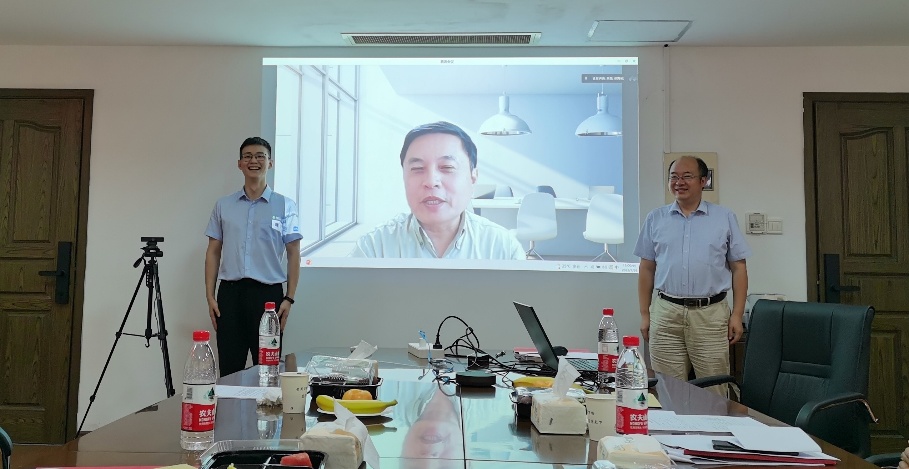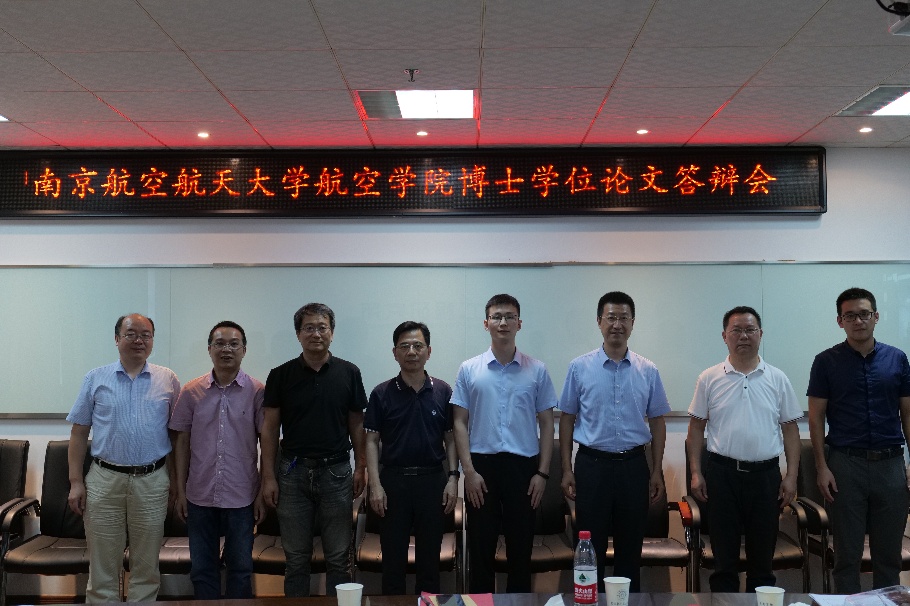2022年7月26日下午1时,团队博士研究生吴昆在南京航空航天大学明故宫校区航空学院705室进行学位论文答辩。答辩主席为东南大学机械工程学院费庆国教授,答辩委员有南京理工大学理学院章定国教授,南京航空航天大学航空学院裘进浩教授、赵永辉教授和何欢教授。答辩主持人为南京航空航天大学航空学院孙加亮副教授。
吴昆博士师从胡海岩教授和王立峰教授,主要研究方向为超材料的波动力学与控制,博士论文题目为《多胞超材料的波动特性优化研究》。经过一个半小时的汇报和提问环节,吴昆博士获得了答辩委员会的一致认可,期间也对多个该领域前沿问题进行了热烈的讨论。最后,经过答辩委员会投票表决,一致通过吴昆同学的博士学位论文答辩,并建议授予工学博士学位。


论文摘要:
弹性波/声波超材料是通过微结构设计实现波动调控并满足相应波动功能的人工材料和复合结构。其研究涉及包括波动力学、振动控制、智能结构设计和先进成型制造等诸多课题,近二十年来受到广泛的关注,并在弹性波调控、地震波防护、结构低频振动抑制等方面展现出重要的应用前景。与此同时,现有的超材料弹性波动研究还存在很多问题值得关注,包括以弹性波动属性为设计导向的超材料优化、低频区间的弹性波带隙拓展以及非线性弹性波动特性的探索等。
本文采用波动频散分析、波动传递率分析、动响应数值计算和振动实验测试的研究方法,对粘弹性超材料、多胞周期超材料、非周期超结构和刚度非线性超材料的波动响应及波动性能参数优化进行研究,主要内容如下:
1. 研究了一维周期性粘弹性超材料的波动特性。针对光敏树脂类材料的粘弹性力学性质,建立了粘弹性局域共振型超材料模型,并设计了对应的超材料实验件构型。振动实验测试了简谐波和随机波在粘弹性超材料中的传播情况,验证了频散分析中带隙区的弹性波衰减特性。分析了粘弹性参数对波动频散关系和波动幅值传递率的影响,根据弹性波衰减带宽和衰减程度的目标需求选取了合适的粘弹性材料。将粘弹性超材料实验件应用于空间桁架结构的低频振动抑制,实验结果表明在指定频率区间可使位移激励的振动幅值大幅降低。
2. 针对超元胞中含多个局域共振单元的周期超材料,提出了一种可实现低频连续宽带及强波动衰减的超材料优化设计方案。通过参数分析,研究不同约束条件下内弹簧刚度分布对超元胞能带结构的影响,将获取连续弹性波动衰减区间、拓宽带隙频段、增强弹性波衰减程度和向低频方向迁移带隙区间作为优化子目标。 考虑平衡弹性波的衰减频域宽度和衰减幅值程度,制定实现低频连续宽带波动衰减区间的优化路径。波动响应的数值计算表明,多胞周期超材料的优化设计表现出良好的宽频波动衰减特性。针对含多频段激励信号和组合激励形式的振动来源, 提出多带隙区间的多目标优化方法,实现超材料在多个激励频率区间内的弹性波衰减。
3. 提出了基于遗传算法的非周期超结构单元内质量分布的参数优化方法。 得到了一维非周期超结构的波动响应解,根据末端单元振动幅值传递率选择波动衰减程度的上临界值,提出了一种高效的基于遗传算法的超结构内质量分布优化方法。优化结果表明,非周期超结构的局域共振单元越多,优化所得的带隙区间越宽;选择的波动衰减上临界值越大,优化带隙区间内的弹性波的阻断性能越好。同时,在结构内质量总和相等的情况下,优化后超结构的带隙区间比周期超材料能够拓宽了近一倍。考虑到弹性波在一维非周期超结构中的传播对称性缺失,优化设计依次实现了超结构的定向波动衰减和双向波动衰减。最后,振动实验验证了非周期超结构在低频宽带区间对正弦和随机形式弹性波的阻断效果,优化后的实验构型展现出比周期超材料更好的双向宽带振动抑制性能。
4. 分析了由刚度三次非线性项引起的含高阶谐波成分的非线性弹性波动响应,并基于参数优化方法对非线性波动现象和特性进行优化设计。借鉴非线性振动中的直接摄动法和谐波平衡法,推导了非线性波动响应的近似理论解,并采用数值计算非线性波动方程的方法验证了非线性波动假设解的可靠性。在超结构的非线性波动响应中发现了波传播的非互易性,表现为将激励和响应位置交换后频响函数相应发生变化。对非线性超结构的局域共振内质量分布进行参数优化,依次实现了非线性波动的带隙区间拓宽、幅值相关的波动衰减设计和弹性波的单向传输。
Abstract:
Elastic/acoustic metamaterial is the artificial composite structure that can manipulate elastic waves and realize innovative wave functionalities through the delicate design of structure configuration. Recent two decades have witnessed a progressive interest in the rapid development of metamaterial investigations, which are involved in several science subjects and engineering technologies, including wave mechanics, vibration control, intelligent structure design, advanced manufacturing, and etc. Current studies on metamaterials provide prominent and attractive applications in many areas, for example, elastic wave manipulation, seismic wave protection and low frequency vibration suppression. However, there remain open problems in the fields of metamaterials within elastic wave: the optimization analysis on metamaterial designs oriented towards unique wave properties, the performance enhancement of elastic wave attenuation at low frequency ranges and the exploration of nonlinear elastic wave propagation.
This dissertation studies the wave analysis and wave characteristics optimization of several elastic wave interaction metamaterials, including viscoelastic metamaterial, multi-resonator periodic metamaterial, aperiodic metastructure and nonlinear metastructure, based on the integrated methods of dispersion analysis, wave transmissibility analysis, numerical computations and experiment studies. The contents and contributions of the dissertation are summarized as follows.
Chapter 2 presents the study on the wave propagation in a locally resonant viscoelastic metamaterial. This chapter begins with the introduction of standard linear solid model into the mass-spring cell, due to the viscoelastic mechanical properties of photosensitive resin utilizing in 3D printing. The complex band structures and transmissibility analysis of both viscoelastic unit cell and elastic cases are presented to show the effect of viscoelasticity. Then, both the harmonic excitation and stochastic excitation are conducted on the fabricated viscoelastic metamaterial in experiments. Distinct wave attenuations are found in bandgap via sweep frequency response analysis under harmonic excitation and via obtained wave response in time domain under narrow-band noise excitation. Moreover, an experiment for the application of vibration suppression reveals a dramatic reduction of excitation amplitude at low frequency ranges, by employing the 3D-printed viscoelastic metamaterial in connection with the space truss structure.
Chapter 3 deals with an optimization scheme for broadband and continuous wave suppression at low-frequency ranges on a type of metamaterial composed of periodic super-cells, each consisting of multiple unit cells. Firstly, this chapter begins with the study on the influence of inner stiffness distributions on the band structures of super-cell with different constraint conditions. Secondly, the chapter introduces four sub-objectives for the optimal designs of metamaterial, i.e., connecting several separate narrow bandgaps, enlarging width of bandgap, reducing wave transmissibility and moving bandgap towards the lower frequency. Thirdly, the chapter turns to establish the corresponding sub-objective functions, as well as the optimization algorithm based on the sequential quadratic programming method and the gradient descent method. The numerical computations on the designed metamaterial confirm the optimized results with both the full responses in time domain and the wave transmissibility in frequency domain. Besides, the end part of this chapter presents an optimization strategy for multiple target frequency ranges of bandgaps, so as to realize wave suppression in metamaterial under the excitations with multi-frequency ranges.
Chapter 4 presents a genetic algorithm based optimization strategy on the aperiodic metastructure, for the broadband wave attenuations and low vibration transmissibility in both one single direction and two opposite directions. Firstly, this chapter begins with the derivation of analytic wave solution for the aperiodic metastructure with multiple diverse resonators. Then, the chapter outlines an optimization scheme with an adjustable inner mass in each cell, based on the vibration transmissibility of end visible mass and selected upper bound of wave suppression. The larger number of locally resonant cells selected in the structure promotes the performance of wave attenuations by enlarging the optimized bandgap, while the higher bound selected in the optimization process leads to the stronger wave suppression with lower wave transmissibility. Besides, the optimized bandgap is nearly doubly broadened with an adjustable inner mass in each cell, compared with the conventional repetitive local resonance, without any mass increase. Specifically, both the unidirectional and omnidirectional wave attenuations are obtained by proposing different objective functions in the optimization scheme, due to the lack of symmetry for elastic wave propagations in the aperiodic metastructure. Finally, the experimental studies of a 3D-printed lattice metastructure validate the good performance of broadband wave suppression under both harmonic and random excitations, as well as better omnidirectional wave attenuations compared with the periodic metamaterial.
Chapter 5 studies the generation of super harmonic wave in a multi-cell aperiodic structure with nonlinear stiffness, as well as the parametric optimization on the nonlinear wave characteristics. Firstly, an analytical approach, integrated with the direct perturbation method and the harmonic balance method, is developed to obtain nonlinear wave response with spectrum of higher order harmonics. The incorporation of cubic nonlinearity brings nonreciprocal wave phenomena, concerning the breaking symmetry of energy transmission between action and reaction, which are discussed via both analytical approach and numerical computation. Further, this chapter presents the parametric optimization on the distribution of multiple local resonances in the nonlinear structure. As a result, the optimized metastructures exhibit noteworthy wave properties, including the broadband nonlinear wave suppression, the tunability of wave attenuation dependent on excitation amplitude, and the unidirectional wave transmission.
博士期间发表论文:
Kun Wu, Haiyan Hu, Lifeng Wang. Experimental study on wave propagation in one-dimensional viscoelastic metamaterial. Acta Mechanica Solida Sinica, 2021, 34(5): 597-611.
Kun Wu, Haiyan Hu, Lifeng Wang. Optimization of a type of elastic metamaterial for broadband wave suppression. Proceedings of the Royal Society A: Mathematical Physical and Engineering Sciences, 2021, 477(2250): 20210337.
Kun Wu, Haiyan Hu, Lifeng Wang, Yuqiang Gao. Parametric optimization of an aperiodic metastructure based on genetic algorithm. International Journal of Mechanical Sciences, 2022, 214: 106878.
Kun Wu, Haiyan Hu, Lifeng Wang. Nonlinear elastic waves in a chain-type of metastructure: Theoretical analysis and parametric optimization. Nonlinear Dynamics: Under review.
Dan Wang, Kun Wu, Guanlin Li, Lifeng Wang. The viscoelastic mechanical property and constitutive models of 3D printed photopolymer. Rapid Prototyping Journal, 2021, 27(2): 346–354.
Yuqiang Gao, Lifeng Wang, Wei Sun, Kun Wu, Haiyan Hu. Ultrawide bandgap in metamaterials via coupling of locally resonant and Bragg bandgaps. Acta Mechanica, 2022, 233(2): 477-493.
Leiyu Yang, Lifeng Wang, Kun Wu, Yuqiang Gao. Splitting of waves in rotor-in-rotor nonlocal metamaterials by internal rotor coupling. Materials & Design, 2022, 221: 110921.
毕业博士简介:
吴昆,男,1994年7月生于安徽省滁州市。2011年9月考入南京航空航天大学工程力学专业,2015年6月毕业并获得学士学位。2015年9月起,进入该校力学专业攻读博士学位,从事超材料波动力学与优化研究,导师胡海岩教授和王立峰教授。





